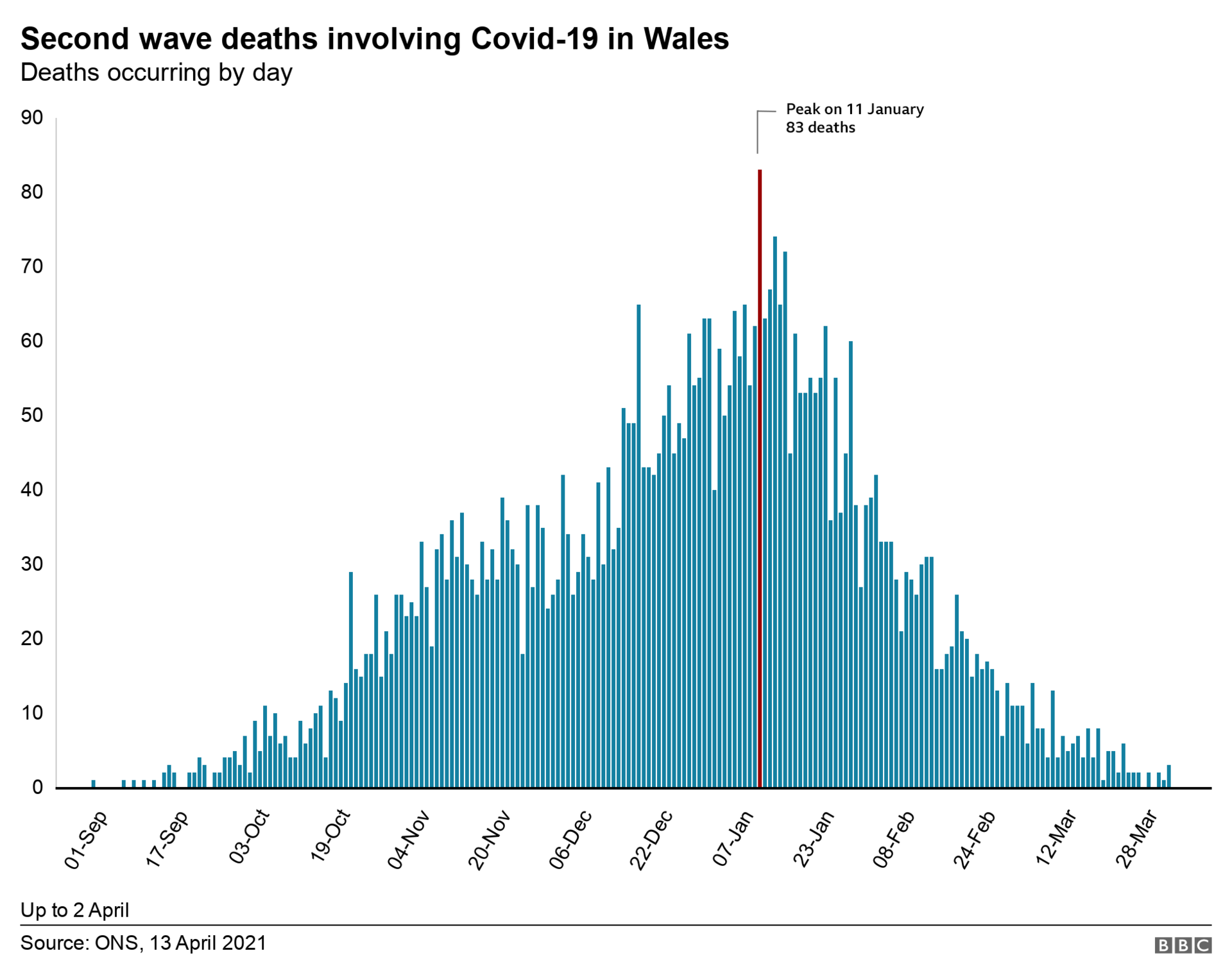Covid deaths in Wales 85% down on a month ago
- Published

Rhondda Cynon Taf has had the highest mortality rate in Wales during the pandemic but Covid deaths have fallen to 12 in the last month and none in the most recent week
The number of deaths involving Covid-19 has fallen for the 11th week in a row in Wales - and it is at its lowest weekly total since September.
There were 15 deaths involving the virus, accounting for 3.1% of all deaths, according to the Office for National Statistics (ONS)., external
This shows a continuing, steady decline and is 85% fewer Covid deaths than registered only a month ago.
The total number of deaths since the pandemic began is now 7,819.


No Covid deaths in eight local authority areas
During the latest week, up to 2 April - there were five deaths in the Betsi Cadwaladr health board area and four in Hywel Dda, with none across the Cwm Taf Morgannwg health board region.
When broken down by local authority area, there were no deaths involving Covid registered in eight counties: Bridgend, Caerphilly, Gwynedd, Merthyr Tydfil. Neath Port Talbot, Rhondda Cynon Taf (RCT), Torfaen and Vale of Glamorgan.
Over the course of the pandemic, RCT, Merthyr and Bridgend have some of the highest mortality rates involving Covid.
Only one Covid death was registered involving a care home resident, from Anglesey, the lowest weekly number again since September.
Care Inspectorate Wales, which reports notifications of deaths of care home residents separately, external, said numbers of deaths from all causes had gradually fallen since March and were below averages for 2019 and 2018. Although there had been a rise in recent days, they still remained below average


What about 'excess deaths'?
So-called excess deaths, which compare all registered deaths with previous years, are now below the five-year average for the fifth successive week.
Looking at the number of deaths we would normally expect to see at this point in a typical year is seen as a reliable measure of the pandemic.
The number of deaths in Wales fell to 483 in the week ending 2 April. This was 182 deaths (27.4%) fewer than the five-year average.
That proportion below average is greatest in Wales than England and all its regions for this week.
ONS said some caution is needed with interpreting this period because of the Easter holidays falling in different weeks over the years.

When looking across the course of the pandemic so far, there have been 41,208 deaths from all causes, 7,812 mentioning Covid-19 on the death certificate. This was 5,808 deaths above the five-year average.
When deaths occurring up to 2 April, but counting later registrations are included, the total number of deaths involving Covid rises to 7,819.
We can see the peak of the second wave came on 11 January, when there were 83 deaths involving Covid.
This was higher than the peak in the first wave, when there were 73 deaths on 12 April.
ONS found across England and Wales, the biggest decrease in the latest week was in deaths of those in their 90s. While more than 60% of deaths involving Covid were in people aged 75 years and over, the proportion has been decreasing.
The different measures for looking at deaths involving Covid-19 in Wales
Why do we look at the ONS figures?
ONS takes longer to report deaths than Public Health Wales (PHW), because it waits for deaths to be registered.
But this is regarded as giving a fuller picture.
These count Covid when it is mentioned on death certificates by doctors, who either suspect or confirm it as a contributory factor in a death. But it is estimated that in Wales, around 85% of deaths where Covid is mentioned, it is the underlying cause of death - so these deaths are due to Covid.
Unlike the PHW "snapshot" daily report, the ONS figures involve deaths in not only hospitals and some care homes, but in hospices and people's own homes.
- Published8 April 2021

- Published28 May 2024
